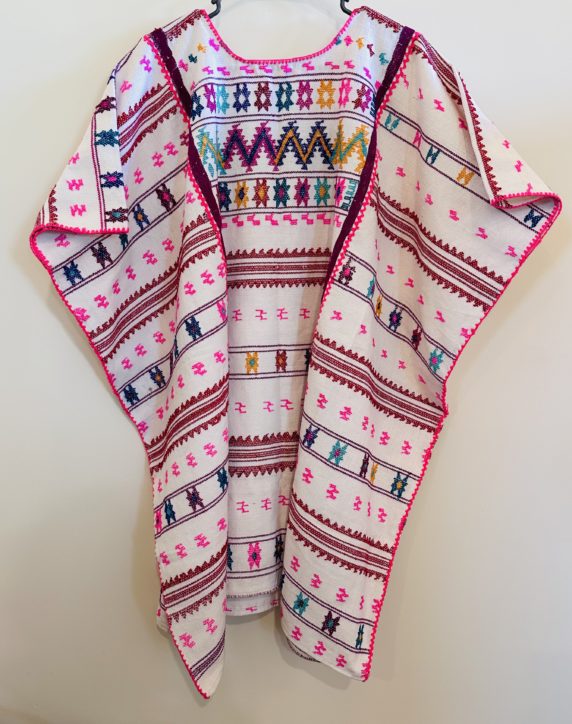Yesterday, Oaxaca government announced that the use of face covers is mandatory throughout the city, that all public squares, where the greatest number of infections occur, will be sanitized, and that police will enforce social distancing to prevent concentrations of crowds. They continue to encourage isolation.
This is good news for Oaxaca.

More face masks are needed. I just ordered 100 masks to be made and mailed to Oaxaca. I am organizing a distribution task to give the masks away starting in the public markets and with street vendors and customers. We have created hang tags for each mask that will explain in Spanish why it is vital to use the mask to prevent the spread of infection and save lives. My goal is to enlist helpers to distribute the masks in Oaxaca and the villages. We will need hundreds of mask and funds to pay local people to hand them out.
Please help me support this effort and make a gift to my PayPal account, designating that it is for the Mask Fund: paypal.me/oaxacaculture or open PayPal, use Send Money to Friends and Family, for oaxacaculture.me

Food Needed for Children and Families
Kay Michaels, owner of Oaxaca Eats Food Tours, tells me this:
Centro Esperanza Infantil / Oaxaca Street Children (CEI) is one of the non-profits that Oaxaca Eats Food Tours supports through a percentage of ticket sales. Dean [Michaels] and I have also donated directly to Oax Street Children They currently support 558 students from kindergarten to college.
Last week, Erich Hansen (you met him at the chef’s party with Kalisa) and I spent about 2,000 pesos at Sam’s Club to buy rice, beans, and oil. We delivered it to Martha Canseco Bennetts – CEI Board Chair and owner of Becari Language School. She delivered it to CEI.
Families also need cash donations in order to afford transportation into Oaxaca. Some of the supported students live 2-4 hours away. Getting in to Oaxaca for donations is quite a journey.

Resources for Giving and A Cry for Help in Oaxaca
- SiKanda.org Solidaridad Internacional Kanda (SiKanda) AC is a Oaxaca non-governmental, and non-profit organization. It was founded ten years ago with the mission of facilitating and leading participatory processes of harmonious and sustainable development to improve the quality of life of people in Oaxaca, Mexico. They are raising money to feed vulnerable families during the COVID-19 crisis. Donate via PayPal from their home page.
- PuenteMexico.org works with 30 communities in the Oaxaca Central Valleys and Mixteca to grow and distribute healthy food, develop sustainable agriculture programs, and provide public health education. They support over 16,000 people. You can donate here.
- Huacal is a food basket delivery service created by Sirilo and Oaxacking that sources food from Abastos Market, packs it into weekly portions, and distributes it now to those in need. It costs 350 pesos to feed a family of 4 each week. You can donate here.

Masks for Oaxaca Hospitals and Clinics
Tlayudona is organizing an effort to create high-quality reusable masks to donate to local hospitals and clinics in Oaxaca. We are looking to create a sustainable effort that will supply local medical personnel with much-needed masks. At the same time, this project will provide living wages for several of Tlayudona´s hosts who no longer have work because of the pandemic. We ask that you donate what you can to support this effort.







Agave Beverage of Choice? Aguamiel, Pulque and Mezcal
Here we are in Oaxaca, Mexico, center of the universe for the cultivation, production, distilling and bottling of agave nectar we call mezcal. Mezcal is hot. A hot commodity, that is.
I stand corrected! Agave is not a cactus. It is a succulent. Thanks to reader Andrew for bringing this to my attention. I’ve changed the post title.
A local friend told me his uncle sold his espadin agave field for 40,000 pesos when it reached maturity after seven years. It takes a long time to make $2,200 USD equivalent here, even at today’s exchange rate. But, that’s a lot of lana (money) and a farmer is happy to hold this crop for a while. The price of agave piña has risen exponentially, 15 times greater than it was seven years ago, according to Alvin Starkman, operator of Mezcal Educational Excursions.
For the last week, I’ve been drinking a cup of aguamiel in the morning. Zapotecs in the know say that aguamiel has curative, medicinal powers and aids in daily digestion. I’m a believer.
Aguamiel is the sap that comes from the heart of the agave when you cut the top off. Honey water. That’s what they call it, and it tastes like it. After one day unrefrigerated, it begins to ferment and after a few days will become pulque. An acquired taste. After four days of fermentation, you are drinking pure bubbling alcohol that goes from clear to cloudy. Some flavor it with fruit or oatmeal to sweeten the taste.
Last week, I tasted tepache in the Tlacolula market. (Find the stand next to the row of ice cream vendors on the rug sellers street.) This is pulque with fermented fresh pineapple. A half a cup before lunch and I needed the arm of a friend to steady me. But, it sure was tasty. In the U.S. with the absence of pulque, some tepache recipes call for beer and pineapple!
Which brings me to mezcal, the epitome of distilled beverage in these parts.
I am not even close to being knowledgeable, but I now have about 14 bottles of locally produced mezcal in my collection. I added the last six — plastic bottles, mostly with the Coke label, filled at the source — during a day-long mezcal education tour with Alvin Starkman. (Plenty of tasting, too.) Nine family members and friends joined me. Those who flew away, left with officially bottled and sealed beverages, thanks to Alvin.
It takes an education and time to understand mezcal and one-day is just the beginning. So is a collection of 14 bottles. Hardly enough to matter to the serious collector.
On the trip with Alvin, I learned that I like tepeztate and clay distilled espadin. Clay gives the mezcal the flavor of loam and fire. I used to really like añejo and reposado, and these are very smooth. Now, however, what tickles my nose and throat are the nuances of the herbs and earthiness of the wild agaves.
Stick your nose in the glass. Inhale. Get that full smokey aroma from the roasted-over-wood agave heart (called piña or pineapple) into your lungs. Then sip. Just a little bit. Second sip, take a little more. You’ll see that what might have felt harsh to your throat at first is now subtle and delightful.
Each type of cactus will make a different type of mezcal. Maybe it’s an espadin distilled with a turkey breast (pechuga de pavo) hanging over the copper pot. Now, there’s a flavor worth trying. Is it fermented in oak, pine, a bull skin, plastic or stainless steel, and for how long? This impacts the flavor. Is it made from a tobala, Karwinskii or madrecuixe agave. Are fruits or poleo (wild mint) added for flavor? And what about that worm?
And what about the microclimates and soil types? Yes, the same agave will produce a different taste with a variation in soil temperature, altitude, and whether the field is shared with weeds or with squash and beans, and when it was last plowed.
Whether you live here or are visiting, mezcal is worth knowing about. It is an ancient artisanal craft on par with rug weaving, natural dyeing, clay making and more recently wood carving. Getting out to the palenques on country back roads is a unique experience.
Meeting the men and women who grow the agave and distill it is even more amazing. Many live very simple, humble lives and their production is small. They may not be certified but what they make can be every bit as delicious.
When you go to the source, you are able to buy, too, at a fraction of what you would pay for a bottle in the city. But, it’s not really about price, it’s about the adventure!
Mezcal Factoids, thanks to Alvin Starkman:
A Few Mezcal Resources:
Note: Most of these photos were taken on the trip with Alvin Starkman. Others were shot during an independent adventure I took with my son, sister and brother-in-law to San Juan del Rio the week before.
Like this:
15 Comments
Posted in Cultural Commentary, Oaxaca Mexico art and culture, Photography, Travel & Tourism
Tagged agave, aguamiel, Alvin Starkman, cactus, education, facts, history, Mexico, mezcal, Oaxaca, pulque, resources, tour